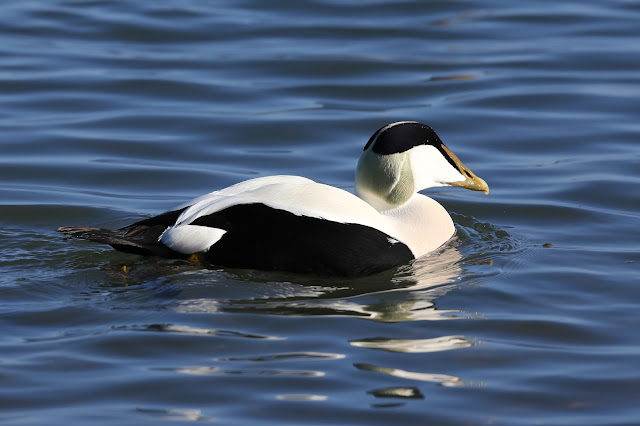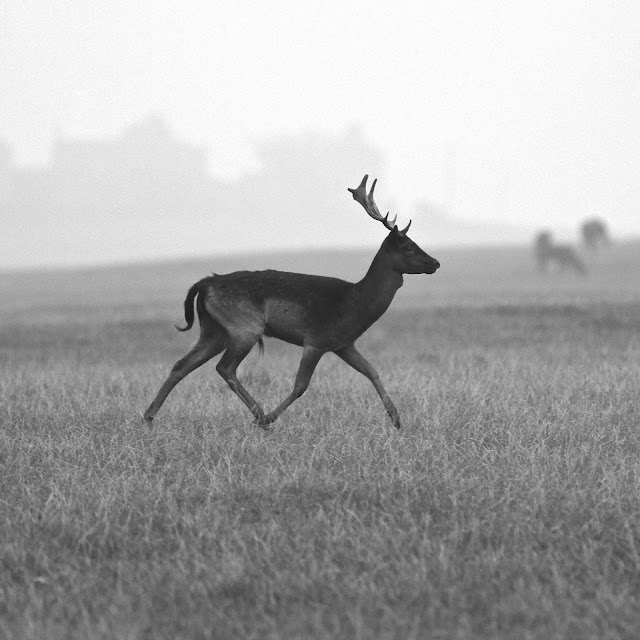These were at St Mary's, also at 1/50s and 600mm. Modern digital cameras and stabilised lenses are pretty amazing.
My Blog List
Monday, 31 October 2016
Posing robins
One good thing about robins is that they will sit still for a portrait, unlike most other birds which are very fidgety. This one was at Wallington in very poor light but I managed these at 1/50s with a 600mm lens.
Saturday, 29 October 2016
Bird of the week - Common eider
These, I think, are first year males just starting to develop some of their adult plumage.
Here are male, female and youngster.
While I was watching, the male birds were spending a lot of time and effort trying to impress the females. The male does this by swimming in front of a female, shaking his head from side to side and then throwing his head back and making a lovely cooing sound. The female sometimes responds with a grunt but whether in approval or disapproval is hard to say.
The eider's scientific name is Somateria mollissima, somateria meaning wool-bodied, and mollisima meaning softest. The females line their nests with their own feathers which were (and are) collected to make eiderdown. The French name for the common eider is "eider à duvet", duvet in French meaning down.
Here in the North East of England we are at the southern limit of the eider's breeding range, as shown on BTO BirdAtlas maps and the EBCC distribution map. Some birds move a little farther south in winter.
The common eider is also widespread in North America and was painted by John J Audubon. You can read his account of the eider here.
Thomas Bewick also drew the common eider (a male) for his A History of British Birds (1832).
Eiders make a lovely cooing sound which you can hear here. Listen to Chris Watson's BBC Radio 4 Tweet of the Day on eider ducks here. And watch a short RSPB video here.
Friday, 28 October 2016
The stag party
I recently went on a visit to Raby Castle to see the red and fallow deer, organised by the Natural History Society of Northumbria. Our guide was Iain Alexander, head gamekeeper on the estate. It was dark and foggy when we arrived, which Iain described as "atmospheric", but which made for difficult conditions for photography, especially as the deer preferred to be under the trees where it was even darker. They were more interested in finding acorns than in posing for the camera.
The Raby fallow deer are mostly melanistic (almost black), which also doesn't help photograph them in very poor light. These few photos below were the best I could manage. The estate also has a large of red deer but they kept their distance and were even more elusive.
The Raby fallow deer are mostly melanistic (almost black), which also doesn't help photograph them in very poor light. These few photos below were the best I could manage. The estate also has a large of red deer but they kept their distance and were even more elusive.
Thursday, 27 October 2016
Wednesday, 26 October 2016
Wallington squirrel
I haven't been to Wallington for a while so it was good to see that the squirrels are still OK. The light is poor at this time of year near the hide so this photo is at ISO 1600 and 1/50s. You can see his whiskers are blurred but the rest isn't too bad.
Monday, 24 October 2016
Goldcrests at St Mary's
A few more of this year's influx of goldcrests, this time from St Mary's, Whitley Bay. They always look a bit sad or sorry for themselves. These photos are from last week but a few were still there this afternoon.
Saturday, 22 October 2016
Bird of the week - Jack snipe
Jack snipes are small and elusive and are usually not easy to see but we are lucky to have a few near the main hide in Gosforth Park Nature Reserve at present. When visible, the birds are nearly always in shade at the edges of the reeds and the photos are all a bit distant and cropped but are not too bad considering. Jack snipes differ from common snipes in being smaller with a proportionately shorter beak and a dark top to the head. Their stripes glow like gold leaf as they run around. The birds characteristically bob up and down while feeding. Their beaks are often covered in thick mud.
They are hard to spot if they don't move and are beautifully camouflaged.
Jack snipes usually keep out of the way of water rails.
The jack snipe is Lymnocryptes minimus, meaning smallest marsh-hider. "Jack" means small. It breeds in Northern Europe and is a winter visitor in the British Isles.
The latest BirdTrack data show jack snipes began arriving in the UK last month.
This EBCC map shows its breeding range.
Thomas Bewick knew the jack snipe as the Judcock.
He wrote that it is cooked in the same way as a common snipe and is just as delicious! He doesn't say how many birds would make up one serving.
You can watch a BTO video on identification of common snipe and jack snipe here. And listen to Chris Watson's BBC Radio 4 Tweet of the Day on jack snipe here.
Subscribe to:
Comments (Atom)





























































